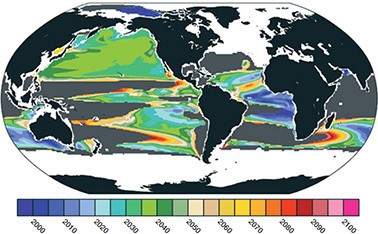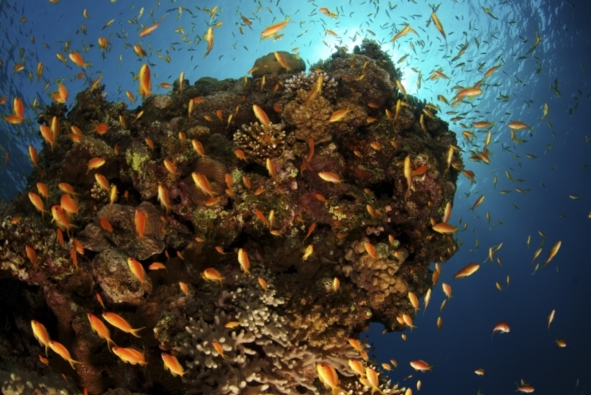Ocean’s Oxygen Starts Running Low
ENVIRONMENT, 9 May 2016
Niina Heikkinen | ClimateWire – Scientific American
Rising levels of CO2 are making it hard for fish to breathe in addition to exacerbating global warming and ocean acidification.
2 May 2016 – Climate change is doing more than warming the world’s oceans. It’s also making it harder for marine life to breathe.
Curtis Deutsch, associate professor at the University of Washington’s School of Oceanography, studies how increasing global temperatures are altering the levels of dissolved oxygen in the world’s oceans. Scientists have been warning that decreasing amounts of available oxygen will increase stress on a range of species, even as they also face the effects of rising temperatures and ocean acidification.
Deutsch’s latest research is untangling how much oxygen loss is linked to climate change and how much is due to normal variation in oxygen levels.
“As the climate goes up, the amount of oxygen will go down, but it’s really hard to look in the ocean to see that change,” he said.
Using an earth system modeling approach, Deutsch and scientists at the National Center for Atmospheric Research and the Georgia Institute of Technology mapped out changing oxygen levels across the world’s oceans through the end of the 21st century.

New research from the National Center for Atmospheric Research finds that ocean deoxygenation will likely become widespread between 2030 and 2040. Other parts of the ocean, shown in gray, will not have detectable loss of oxygen due to climate change even by 2100.
Graphic courtesy of Matthew Long, NCAR.
They found that it was possible to distinguish the impact of global warming from other sources of oxygen loss. As soon as 2030 to 2040, climate-driven declines in oxygen levels will be detectable in oceans all over the globe. In some places, like the southern Indian Ocean and parts of the eastern tropical Pacific and Atlantic basins, evidence of climate-linked deoxygenation is already apparent, while other regions won’t see changes by 2100.
The researchers recently published their results in Global Biogeochemical Cycles.
“In some parts, you can actually detect a change relatively early, like right around now. The signature of the climate being warmer is creating something that is unlike anything that is seen in history. Other places it is much harder to detect, either oxygen is decreasing slowly or there is so much [natural] variation. So basically the results depend on where you are,” Deutsch said.
Ocean O2 studies are challenging
The influence of climate change was evident in areas with either extreme incidents of oxygen depletion or longer-than-normal trends of low oxygen levels. Places like the southern Indian Ocean that showed the strongest warming signal the soonest tend to be the areas that will see the worst affects of warming, he explained.
Those changes have a significant impact on a wide range of marine life.
“Oxygen is playing a fundamental role in where species can live or not live,” he said.
For each degree of ocean warming, oxygen concentration goes down by 2 percent. Over the short term, the higher temperatures slow the rate of ocean circulation, exacerbating regional oxygen depletion. The rising temperatures cause layers of ocean water to stratify so the more oxygen-rich surface waters are less able to mix with oxygen-poor waters from the deeper ocean.
At the same time, the higher temperatures are putting more stress on marine species, causing their metabolisms to speed up and their need for oxygen to increase.
“So you have effects squeezing them on both sides,” Deutsch said.
Conducting global research on how climate change is impacting ocean oxygen levels has been an ongoing challenge for ocean scientists. One problem is that researchers haven’t been studying ocean oxygen levels that long, so there isn’t an extensive history of data collection to draw on.
Even when ocean oxygenation is studied, the number of places where oxygen levels have been sampled is limited. And because sampling isn’t necessarily consistent over time, it’s possible that researchers may turn up low or high oxygen readings that are actually anomalies.
That leaves scientists still asking the question—how much is global warming limiting oxygen availability worldwide?
“You can never really answer that with data, we just have the data we have. The only way to do that is to use models to ask how long should it take for the signal of warming to be clearly outside the norm,” Deutsch said. “We are still sort of at the early stages of the global warming phenomenon, and CO2 is rising much faster this century than the last century.”
Impacts well beyond acidification
To make their predictions even better, Deutsch would like to see broader use of ocean oxygen monitoring through close to 4,000 Argo floats, autonomous ocean robots that collect data and send information to satellites. Currently, the floats are primarily used to collect temperature and salinity data, but the technology exists to test oxygen levels and acidity as well, he said.
The computer modeling they used in their study was able to identify when and where oxygen levels would likely reach historic lows that could not be recovered from, by simulating natural ocean processes and showing broad-scale patterns across the globe.
“This is exactly the kind of research we have been waiting for in the field,” said Francis Chan, an associate professor in Oregon State University’s Department of Integrative Biology, who was not involved in the study. Chan studies ocean oxygen concentrations off the coast of Oregon.
He described the researchers’ findings as “sobering” and a confirmation of ocean changes recorded in other observational studies.
“This is more of an eye-opener, the changes we have been concerned about, they are stronger and closer at hand than many of us want,” Chan said.
Previous research has also suggested that ocean oxygen levels are going down globally. A study published in Geophysical Research Letters in 2011 found widespread declines in oxygen concentration in the upper ocean between the 1970s and the 1990s. The Australian scientists conducting the study suggested the main driver of the oxygen loss was increased stratification between surface waters and the deeper ocean, preventing oxygen from mixing sufficiently.
Other researchers, like Tony Koslow, a research oceanographer emeritus at Scripps Institution of Oceanography and former director of the California Cooperative Oceanic Fisheries Investigations, have focused on how the changes in oxygen levels affect marine life.
“I think there is good evidence that oxygen levels are declining already due to warming, and there aren’t any natural patterns that would lead to global decline,” he said.
Koslow has researched the impact of climate-change-driven warming on what are known as oxygen minimum zones (OMZs), naturally occurring low-oxygen regions found well below the ocean’s surface. In 2011, he published a study on how populations of fishes that live just above the OMZs off the southern coast of California had changed since the middle of the 20th century.
Koslow and his colleagues found that since 1951, 24 taxa of these mid-water fishes had declined more than 60 percent. Meanwhile, in the last 20 years, the OMZ had expanded upward toward the ocean surface by 40 meters, and oxygen levels had fallen by 20 percent in the past decade. Koslow hypothesized that the decreased oxygen had forced the fishes closer to the surface, where they were more vulnerable to predators. He described the decline of this magnitude as “potentially of huge significance.”
Though the fishes were not commercially valuable, they are an important source of food for marine predators like other fish, squid and whales, and help to support ecosystem health. More broadly, previous research had found that oxygen levels had declined in OMZs in the Indian, Pacific and Atlantic oceans since the 1950s.
Koslow said that for the most part, the public was not as aware of the effects of climate change on ocean oxygen levels.
“People talk a lot about climate change, but when they talk about the effects on the ocean, they talk about temperature and acidification. But the effects on oxygen are very large, and they are effects that we are seeing already,” Koslow said.
___________________________________
Recent Articles by Niina Heikkinen
- Penguin Populations Are Changing Dramatically
- Stop Wasting Food to Slow Global Warming
- U.N. Aims to Protect More of the High Seas
Recent Articles by ClimateWire
- Self-Driving Taxis May Hit the Road within a Year
- Can Tesla Build Enough Electric Cars?
- Could a Lack of Water Cause Wars?
Reprinted from Climatewire with permission from Environment & Energy Publishing, LLC. www.eenews.net, 202-628-6500
Go to Original – scientificamerican.com
DISCLAIMER: The statements, views and opinions expressed in pieces republished here are solely those of the authors and do not necessarily represent those of TMS. In accordance with title 17 U.S.C. section 107, this material is distributed without profit to those who have expressed a prior interest in receiving the included information for research and educational purposes. TMS has no affiliation whatsoever with the originator of this article nor is TMS endorsed or sponsored by the originator. “GO TO ORIGINAL” links are provided as a convenience to our readers and allow for verification of authenticity. However, as originating pages are often updated by their originating host sites, the versions posted may not match the versions our readers view when clicking the “GO TO ORIGINAL” links. This site contains copyrighted material the use of which has not always been specifically authorized by the copyright owner. We are making such material available in our efforts to advance understanding of environmental, political, human rights, economic, democracy, scientific, and social justice issues, etc. We believe this constitutes a ‘fair use’ of any such copyrighted material as provided for in section 107 of the US Copyright Law. In accordance with Title 17 U.S.C. Section 107, the material on this site is distributed without profit to those who have expressed a prior interest in receiving the included information for research and educational purposes. For more information go to: http://www.law.cornell.edu/uscode/17/107.shtml. If you wish to use copyrighted material from this site for purposes of your own that go beyond ‘fair use’, you must obtain permission from the copyright owner.
